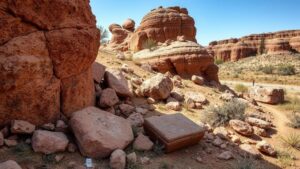Unearthing Loot Buried Beneath Overgrown Trail Junctions
Unearthing Loot Buried Beneath Overgrown Trail Junctions
The phenomenon of buried loot beneath overgrown trail junctions captures the imagination of treasure seekers, historians, and archaeologists alike. These locations serve as historical landmarks where trade routes intersect, making them hotspots for treasure concealment and eventual abandonment. This article delves into the context, techniques, implications, and case studies associated with unearthing hidden valuables in these significant sites.
Historical Context: Why Are Looted Treasures Buried?
Throughout history, trail junctions have functioned as critical nodes for trade and transportation. During times of conflict, travelers often buried valuables to prevent them from falling into enemy hands. For example, during the American Civil War, soldiers frequently buried gold and personal belongings near trail junctions for safekeeping.
Also, the economics of early American pioneers led them to cache important resources as they ventured into uncharted territories. In crowded ports and bustling towns, trade goods, cash, and precious metals were sometimes hidden in anticipation of future need or to deter theft.
Modern Techniques for Unearthing Buried Loot
Unearthing treasures requires a blend of traditional techniques and modern technology. Below are some commonly used methods:
- Metal Detection: This method has revolutionized treasure hunting. Advanced metal detectors can distinguish between different types of metals and provide depth readings, making them invaluable at historical sites.
- Ground Penetrating Radar (GPR): This non-invasive technique uses radar pulses to image the subsurface. GPR can reveal disturbances in soil that may indicate buried objects.
- Excavation and Test Pits: When electronic methods indicate potential findings, archaeologists may resort to careful excavation, using test pits to assess the area without destroying historical context.
Ecological Considerations and Site Preservation
Overgrown trail junctions often harbor sensitive ecosystems. It is crucial to approach the excavation of these sites with ecological awareness. Disturbing the landscape can lead to erosion, habitat destruction, and loss of biodiversity. A balanced approach entails using sustainable excavation methods and ensuring compliance with local conservation laws.
For example, the National Register of Historic Places encourages the preservation of archaeological sites, emphasizing the importance of blending archaeology with ecology. As such, treasure hunters and archaeologists should collaborate with environmental experts to minimize the impact of their activities.
Case Studies: Notable Sites of Buried Treasures
Several historically significant sites exemplify the concept of treasures buried near trail junctions:
- The Lost Dutchman’s Gold Mine: Located in the Superstition Mountains of Arizona, legends tell of a treasure buried by a gold miner who took his secret to the grave. While many have sought this hidden fortune, the areas rugged terrain demands respect for both geological and ecological features.
- Fort Union National Monument: Historically, this fort served as a trading post in the mid-1800s. Archaeological excavations have uncovered buried artifacts, offering insights into the forts role in regional commerce. Such discoveries underscore the sites historical significance.
Legal and Ethical Implications of Treasure Hunting
Treasure hunting raises significant legal and ethical questions. Many countries have stringent laws protecting archaeological sites, and unauthorized excavations can lead to legal penalties. For example, the Archaeological Resources Protection Act (ARPA) in the United States prohibits unauthorized excavation on public lands.
Also, the ethical responsibility of treasure hunters necessitates a paradigm shift towards conservation. Individuals are encouraged to work in partnership with local archaeologists, ensuring that any findings contribute to historical knowledge rather than personal gain. This collaborative approach enhances the understanding of the cultural heritage associated with buried treasures.
Actionable Takeaways for Aspiring Treasure Hunters
Those interested in unearthing treasures at overgrown trail junctions should consider the following:
- Conduct thorough research to understand the history of the area and any previous excavations.
- Familiarize yourself with local laws and obtain necessary permits before embarking on any excavation.
- Engage with professional archaeologists to maintain a respectful approach towards historical sites.
- Use advanced technology such as metal detectors and GPR to maximize your chances of successful finds.
The quest for buried loot beneath overgrown trail junctions is an exciting intersection of history, technology, and ethics. By approaching this endeavor thoughtfully, aspiring treasure hunters can contribute positively to our understanding and preservation of the past.



